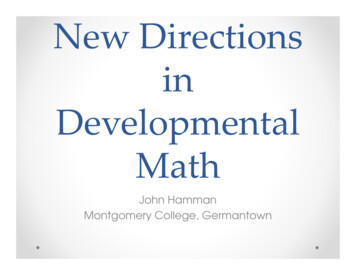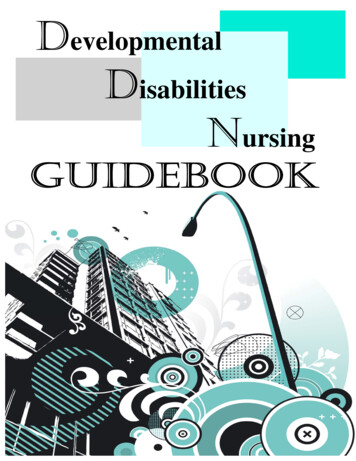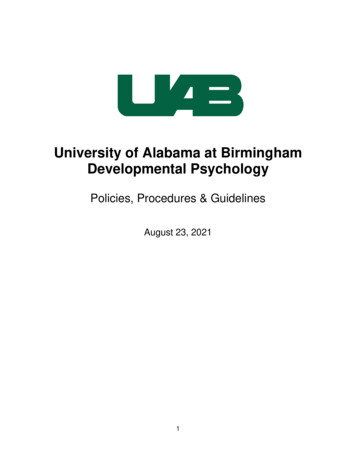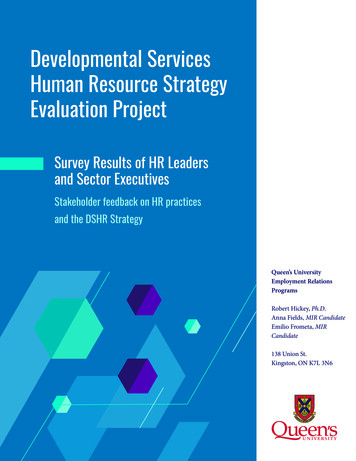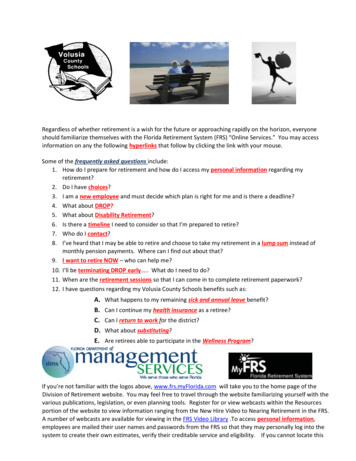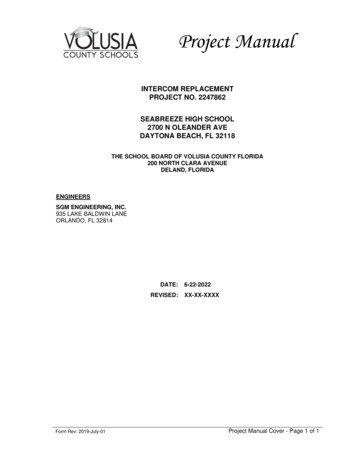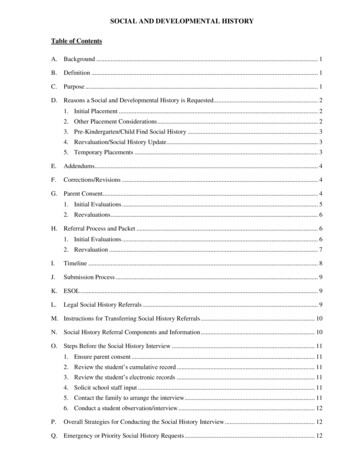
Transcription
SOCIAL AND DEVELOPMENTAL HISTORYTable of ContentsA. Background . 1B.Definition . 1C.Purpose . 1D. Reasons a Social and Developmental History is Requested. 21. Initial Placement . 22. Other Placement Considerations . 23. Pre-Kindergarten/Child Find Social History . 34. Reevaluation/Social History Update . 35. Temporary Placements . 3E.Addendums. 4F.Corrections/Revisions . 4G. Parent Consent. 41. Initial Evaluations . 52. Reevaluations . 6H. Referral Process and Packet . 61. Initial Evaluations . 62. Reevaluation . 7I.Timeline . 8J.Submission Process . 9K. ESOL . 9L.Legal Social History Referrals . 9M. Instructions for Transferring Social History Referrals . 10N. Social History Referral Components and Information . 10O. Steps Before the Social History Interview . 111. Ensure parent consent . 112. Review the student’s cumulative record . 113. Review the student’s electronic records . 114. Solicit school staff input . 115. Contact the family to arrange the interview . 116. Conduct a student observation/interview . 12P.Overall Strategies for Conducting the Social History Interview . 12Q. Emergency or Priority Social History Requests . 12
1. Emergency Referral . 122. Priority Referral . 13R.Out-of-District Social History Reports . 131. Guidelines for Reviewing Social Histories Completed Outside Volusia County Schools . 132. Completing the Social History Approval Form . 133. Copying and Distributing. Error! Bookmark not defined.S.Instructions for Closing Social History Referrals . 14T.Social Service Reports Menu . 15U. Medicaid . 16V. Legal Issues . 16Some Best Practice Guidelines to Follow . 16Other Do’s and Do Not’s of Documentation. 18SOCIAL AND DEVELOPMENTAL HISTORY OUTLINE . 19SOCIAL AND DEVELOPMENTAL HISTORY FLOW CHART . 28
A. BackgroundThe Vocational Rehabilitation Act Amendments of 1973 (Section 504), the American with DisabilitiesAct (ADA) of 1990, and the Education for All Handicapped Children Act of 1975, helped qualify theneed for a Social and Developmental History for students who might receive special education placements.These laws require that all assessments be free from racial and cultural bias.A systems approach is used to develop a Social and Developmental History. The student is related to socialsystems such as family, school, neighborhood, and peers; each system should be addressed. While theschool social worker meets with the student’s family, family intervention is not the primary objective.B. DefinitionA Social and Developmental History is the appraisal (by a school social worker) of the factors that mayimpinge upon a student’s ability to learn and function optimally in school. A social history adds to thediagnostic information related to the student and his/her needs, and “helps guard against the inappropriatelabeling of students based on test scores and school performance alone, without consideration of cultural andlanguage differences.” (The Social History: Best Practice Guidelines for School Social Work Assessment inFlorida, June 1988). This assessment includes information compiled from the following areas: family composition/dynamics/background developmental/medical history educational history socioemotional/behavioral functioning environmental and cultural influencesA Social and Developmental History can be an invaluable tool as an integral part of needs assessmentconcerning which of the three levels of interventions – school-wide, targeted, or intensive – are mostappropriate for a student.C. PurposeThe purpose of the social history is to obtain information about the student that extends beyond the schoolenvironment. The social history report contains interpersonal, familial, emotional, behavioral, academic,and environmental variables that influence the student’s adaptation to school. Multiple sources are used toobtain information including: interviews with parents, teachers, the student, and others; observations of thestudent in multiple settings; and a review of school records and/or agency reports and evaluations. Theprocess includes: developing communication between the school social worker and the parents, often resulting inthe therapeutic effect of more frequent and cooperative home/school contacts identifying conditions that may require further evaluation, referral, or intervention helping parents define their child’s problem and their helping role ensuring that parents understand their due process guarantees1
A school social worker may be part of a multidisciplinary team that may include teacher, schoolpsychologist, school counselor, other staff, or community agency professional. The skills of the socialworker may include: interviewing techniques identifying and interpreting family dynamics that affect a student’s learning non-biased evaluative instrumentsA Social and Developmental History contributes valuable information to the school assessment teams, staff,and parents in identifying students’ strengths and areas of needs, developing interventions and positivebehavior support plans, identifying eligibility for special services in school, and assisting the school socialworker in identifying and connecting students and parents to needed community resources and counseling.Note: Information obtained from The Social History: Best Practice Guidelines for School Social WorkAssessment in Florida, June 1988.D. Reasons a Social and Developmental History is Requested1. Initial PlacementThe social history is required for initial placement in the following programs:a) Autism Spectrum Disorder (ASD)b) Deaf or Hard of Hearing (DHH)c) Dual-Sensory Impaired (DSI)d) Emotional/Behavioral Disabilities (EBD)e) Intellectual Disability2. Other Placement ConsiderationsA social history is not required for initial placement in the following programs. However, if astudent is already receiving services under one of these exceptionalities, the committee may requesta social history if they are considering another exceptionality or additional services:a) Developmentally Delayed (age 0-5)b) Established Conditions (age 0-2)c) Giftedd) Hospital/Homebounde) Language Impairedf) Orthopedically Impairedg) Other Health Impaired (OHI)h) Specific Learning Disability (SLD)i) Traumatic Brain Injury (TBI)j) Visually Impaired2
3. Pre-Kindergarten/Child Find Social HistoryProcedures regarding placements requiring a social history are the same for students in Pre-K.The Child Find Social History (form 2007004, English or Spanish) can be used for initialplacement (completed by the parent). Sometimes, Child Find will request the completion of asocial history report from the school social worker prior to eligibility, but this is on a case-by-casebasis.A social history may be needed for students articulating from Pre-K to Kindergarten, if it is aneligibility requirement or a recommendation by the reevaluation committee.4. Reevaluation/Social History UpdateIn accordance with Section 300.533 of Title 34 of the Code of Federal Regulations (CFR),reevaluation is the process of gathering and reviewing information to determine: if a student continues to have a disability the present levels of performance and educational needs of the student whether the student continues to need special education and related services whether any additions or modifications to special education and related services are neededto enable the student to meet the measurable annual goals on the IEP and to participate, asappropriate, in the general curriculumSocial histories are not required as part of the three-year Exceptional Student Education (ESE)Reevaluation. However, a Social and Developmental History or Social History Update may berequested if: the reevaluation committee recognizes a need for additional information that iseducationally relevant and is impacting the student’s present level of functioning a change in a student’s ESE classification/eligibility to any of the aforementionedexceptionalities (i.e., ASD, EBD, etc.) is being consideredThe school social worker should ask school personnel what questions and issues are driving theneed for the Social and Developmental History or Social History Update. Upon reviewing andconsulting with the reevaluation committee, the request for a social history or social history updatemay be completed. Social histories which have been completed within one calendar year or less areacceptable for the consideration of a more restrictive placement.5. Temporary PlacementsIt is not necessary to have a Social and Developmental History or Social History Update whenmoving a student from temporary placement to new, unless a change in a student’s classification/eligibility to any of the aforementioned exceptionalities is being considered. If the student has asocial history from another school district, the school social worker must be provided a copy of theout-of-county/state social history report in order to review and approve. However, the school socialworker should use professional judgment.3
E. AddendumsIf a parent requests to include additional information in the social history report after the report hasbeen completed, the school social worker needs to make an addendum to the report. The addendumincludes the cover page and a one-page report of the additional information. The cover page of theSocial and Developmental History includes the notation “Addendum” and the date of amended report.The one-page report contains the school social worker’s name, title, and date report was amended(similar to the final page of the social history report). The respective Student Services satellite site’sclerical person sends an interoffice memo to the principal, staffing specialist, school psychologist, andthe ESE and Student Services Office informing them of the addendum.F. Corrections/RevisionsIf a parent or school requests to make corrections to an original social history, the following proceduresmust be followed: A meeting with the parent/guardian and principal/designee must occur to ensure all are inagreement of the change of the student’s records. An Agreement to Correct, Delete, or Expunge Student’s Educational Records (form2001176, English or Spanish) must be filled out and signed by the parent/guardian andprincipal/designee and two witnesses. The original social history and completed Agreement to Correct, Delete, or Expunge Student’sEducational Records is sent to Student Records Services. A copy of this form is to be kept inthe cumulative record. The school social worker makes the corrections to the social history report. The cover pageincludes the notation “Corrected” and the date of the corrections. The respective Student Services satellite site’s clerical staff sends the corrected social historyreport with an interoffice memo to the principal/school, staffing specialist, school psychologist,and the ESE and Student Services Office directing them to destroy the original report. If the parent/guardian and principal do not reach an agreement, the principal contacts theDistrict Office of Legal Services.G. Parent ConsentFlorida Statute 1000.21(5) defines “parent” as “either or both parents of a student, any guardian of astudent, any person in a parental relationship to a student, or any person exercising supervisoryauthority over a student in place of the parent.” Part 300 – Assistance to States for the Education ofChildren with Disabilities (300.20) defines “parent” as “a natural or adoptive parent of a child, aguardian but not the State if the child is a ward of the State, a person acting in place of a parent (such asa grandparent or stepparent with whom the child lives or a person who is legally responsible for thechild’s welfare), or a surrogate parent who has been appointed in accordance with 300.515.”According to Rule 6A-6.0333, “An educational surrogate parent is an individual appointed to act in theplace of a parent in safeguarding a student’s rights in the exceptional education decision-makingprocess, when the student’s parent after reasonable efforts, cannot be located by the school district, thestudent is a ward of the state under State law, or the student is an unaccompanied homeless youth.” A4
surrogate parent may be appointed by either the court or by the school district superintendent (ordesignee). Educational surrogate parents receive training developed and approved by the schooldistrict.An agency or group home cannot sign as parent for educational purposes, therefore students that arealready ESE are appointed surrogate parent through IDEA to represent the student in all mattersrelating to the identification, evaluation, and educational placement of the student and the provision ofFAPE to the student. Volusia County School district has approved and trained surrogate parents. Thecompliance office must be contacted for assistance.The Department of Children and Families (DCF) and Community Partnership for Children haveguardianship over children under their supervision in regular education matters. They may sign forthings, such as medical and legal issues for students. It is important to emphasize that a surrogateparent is required for educational decision-making only when the child is or is suspected of needingexceptional student education services. Schools should continue to invite DCF and CPC caseworkersto meetings regarding all students as they may have information critical to the decision-making process.Foster parents of students whose parental rights have been legally terminated may serve as surrogatesonce certain conditions are met.If a student has a school patron and formal documentation is in the cumulative school record andFOCUS student demographics, the school patron will sign the consent in place of the parent/legalguardian who is unavailable to sign. A school patron form allows a person other than the parent/legalguardian to make educational decisions for a student. A school patron form does not establishguardianship, only a judge’s order can grant or change guardianship. There are 2 types of School PatronAuthorization forms and both are located in our procedural manual. Typically, the School PatronAuthorization II requires the school social worker to verify that the parent/legal guardian is deceased orunavailable to sign. The unavailability of a parent/legal guardian must be due to extreme hardshipcircumstances such as the parent/legal guardian’s whereabouts being unknown, is serving anadjudicated sentence, or is incapacitated due to substance abuse or mental health illness, etc. If theSchool Patron Authorization I is the document on file, the school social worker can proceed withobtaining the social and developmental history information but the parent/legal guardian most likelywill need to be the one to consent for placement, if found eligible for services.1. Initial EvaluationsA school social worker should not proceed with an initial Social History Referral unless a Consentfor Formal Evaluation Parent/Guardian Notice has been signed/completed by parent/guardian anduploaded to FOCUS. The school social worker gets an email that the consent has been uploaded toFOCUS; go to school-SSS-Manage Student-ESE-Locked Events and “Notice of Evaluation andConsent for Reevaluation”.Parent revocation, student withdrawal, student unavailable for testing, or eligibility meetingare the only reasons a consent form is “deactivated” once it has been signed by the parent. Allevaluators should be working from the original consent form.Note: In a situation where the social history was not completed by the mandated timeline andin advance of the staffing meeting, the meeting must be cancelled.According to the Special Program and Procedures (SP&P), the school district is not required toobtain informed consent for an initial evaluation if the child is a ward of the State and is notresiding with the parent: The school district cannot discover the whereabouts of the parent; The rights of the parent have been terminated; or5
The rights of the parent to make educational decisions have been subrogated by a judge andconsent for initial evaluation has been given by an individual appointed by the judge torepresent the student.If the parent refuses consent for an evaluation to determine eligibility as a student with a disability,the school district may continue to pursue consent for the evaluation by using the mediation or dueprocess procedures.2. ReevaluationsThe school district ensures that a reevaluation is conducted if the district determines that theeducational or related services needs of the student warrant a reevaluation or if the student’s parentor teacher requests it. The school district will obtain informed consent from the parent of thestudent prior to administering a test or other instrument that is not administered to all students.According to the SP&P, if the parents fail to respond to reasonable attempts to obtain consent,informed parental consent is not required for reevaluation. Documented reasonable attempts include: Detailed records of telephone calls made or attempted and the results of those calls; Copies of correspondence sent to the parents and any responses received; and Detailed records of visits made to the parent’s home or place of employment and the resultsof those visits.Since social history interviews are conducted with the parents/legal guardians, the social historycan only be completed if they are willing to participate in the interview. Written parent consentmust be obtained at the time of the interview.Note: If a parent has given consent for an evaluation and the referral for a social and developmentalhistory was not completed within a timely manner, best practice would be that the reevaluationcommittee reconvene to determine if there is still a need for the referral.H. Referral Process and PacketThe district placement specialist, school psychologist, child find specialist, and the district studentplacement committee are the only district staff members authorized to request a Social and DevelopmentalHistory.1. Initial Evaluations: The State monitors the completion of Psychological Evaluations and SocialHistory Referrals under Indicator 11 of the State Performance Plan and expects 100% compliance.Specifically, according to State Board Rule, “the school district shall ensure that initial evaluationsof students suspected of having a disability are completed within sixty calendar days, with holidaysand summer vacations exempted from the timeline that the student is in attendance after the schooldistrict’s receipt of parent consent for evaluation.”In order to meet the intent of this rule while following best practice, the following procedures arerecommended:a) When a concern is noted with vision, speech, hearing, or an FBA is requested, the ProblemSolving Team Consent Parent/Guardian Notice (form 2009020, English or Spanish) shouldbe provided to the parent. In addition, this form should be provided to the parent when a6
referral for evaluation may be imminent. These screenings should be completed prior to theProblem Solving Team (PST) meeting when possible as results contribute to the analysis of theproblem phase of the PST meeting.b) At the PST meeting, the parent should be provided with informed consent of the evaluation if areferral for formal evaluation is recommended. The parent should complete the Consent forFormal Evaluation Parent/Guardian Notice (form 2006119, English or Spanish) at this time.c) If the parent is not in attendance at the PST meeting, the parent must be made aware of the intentof the evaluation. Simply providing the parent with the consent form or sending the consenthome with a student is not best practice and does not meet the standard of informed consent.Efforts should be made to have the parent come to the school to be provided with informedconsent. If this is not possible, Student Services personnel (i.e., the school psychologist, schoolsocial worker, or school counselor), the PST Chair, or the school administrator must contact theparent regarding the Psychological/Social History Referral in order to obtain consent. At no timeshould the parent consent be signed prior to a team’s decision to proceed with an evaluation andcompletion of the PST paperwork.d) The 60-day timeline begins when the parent consent is signed at the school or if the parent isnot present at the meeting, when the consent is received by the school.e) After receiving email notification that there is an initial evaluation required, locate studentin SSS(1) Open "Notice of Evaluation and Request for Consent" Event, locate signed consent inthe Uploads section of the Event(2) Evaluate the student as required by the Consent and write the report(3) Upload Report as a PDF to the "ESE Staffing Eligibility Determination Meeting"Event under the Uploads tab(4) Open the "ESE/Gifted Tracking and Reporting" Event and fill in the last date of yourEvaluation.(5) If you are the last required Evaluator to complete this step, fill in the "Date of LastEvaluation" box with the latest date of all evaluations completedf) The school social worker will complete the Information For Submitting Completed ReferralsDatasheet and/or the Social History Referral Information For Datasheet This form will besubmitted electronically by the school social worker to the designated office specialist. A copyof the data sheet along with original interview notes and a copy of referral and consent is sent tothe designated office specialist to be filed.If a student transfers following the completion of a referral packet, the school psychologist/school social worker will follow the transfer procedures by signing the referral, completing atransfer sheet, and alerting the receiving school psychologist/school social worker of theimminent transfer.2. Reevaluation: In order to expedite the processing of requests for social histories generated throughthe ESE reevaluation process, the following procedures will be implemented:a) When the reevaluation committee determines that an evaluation and/or social history iswarranted, the designated school staff member processes the consent for evaluations and/or asocial history will be obtained, as has historically been the case. The designated school staffmember processes the social history referral. The date that the parent provides the signedconsent to the school serves as the official date of parent consent.7
b) When the referral packet is complete (i.e., Psychological Referral cover sheet,Reevaluation/Consent Documentation, screening report if applicable), a copy of the completereferral will be uploaded to FOCUS by the assigned designee to the school by uploading thereferrals for evaluation in FOCUS-SSS-manage student-ESE-“ESE Staffing/EligibilityDetermination Meeting.” The Social worker will print a copy from FOCUS and proceed withthe referral. As is policy, the school psychologist and/or school social worker will address thereferrals in the order in which they were received.c) The referral forms include the date of parent consent (i.e., the date the consent was received bythe school). In all cases, the copy of the psychological and/or social history referral packet shallbe provided to the school psychologist and/or school social worker within two days of theparent consent being obtained and completion of the referral packet.d) All referral packets for psychological evaluations and social histories will now be provideddirectly to the school psychologist and/or school social worker assigned to the school whoreceived the email alert that consent for evaluations has been obtained. The social workerhistorically forwards the email to the designated office specialist and adds the student to theirrunning list of referrals for the department data base.I. TimelineThe School Social Services department has a recommended completion date for all social historyassessments within 30 calendar days. This departmental timeline is in place to safeguard the timelycompletion of evaluations, since social history assessments have historically been requested at the end ofthe evaluation process. It is also recommended that the interview once completed be typed up in a timelymanner (i.e., 10-day timeframe unless other approved priorities take place). Pursuant to State Board ofEducation Rule 6A-6.0331, the school board ensures that a student suspected of having a disability isevaluated within a period of time, not to exceed 60 calendar days, with holidays and summer vacationsexempted from the timeline, of which the student is in attendance, after the completion of required activities in general education procedures section of the SpecialPrograms and Procedures manual; the receipt for the parental consent for evaluation; and the receipt of the referral for evaluation.The date on which the last of these requirements is completed is the beginning of the 60-day timeline.The departmental timeline of 30 days will assist with compliance of the 60-day timeline set by the state.The social history report is considered complete when the social worker signs off on the referral.Each social history Data Sheet form contains a due date located in the upper right-hand corner of the form.For initial referrals, this date reflects 30 calendar days from the date the school district receives theparent consent. For reevaluation re
social history report from the school social worker prior to eligibility, but this is on a case-by-case basis. A social history may be needed for students articulating from Pre-K to Kindergarten, if it is an eligibility requirement or a recommendation by the reevaluation committee. 4. Reevaluation/Social History Update
